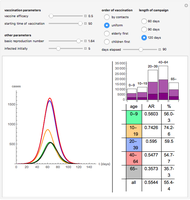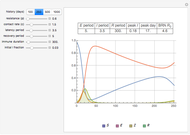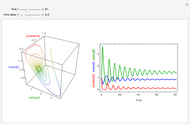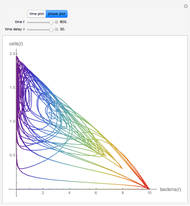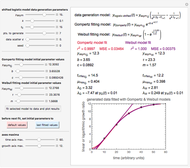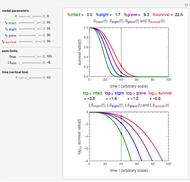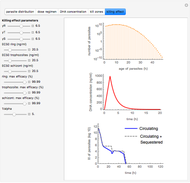A Model of Plasmodium Falciparum Population Dynamics in a Patient during Treatment with Artesunate

Requires a Wolfram Notebook System
Interact on desktop, mobile and cloud with the free Wolfram Player or other Wolfram Language products.
This Demonstration shows a model of population dynamics of malaria parasites (Plasmodium falciparum) in a patient during treatment with artesunate (an antimalarial drug). The model assumes the age of parasites in a patient on admission follows a normal distribution (top graph). The concentration of drug over time is incorporated into the model by assuming that subsequent doses have the same concentration profile (middle graph). The model also assumes the action of artesunate varies depending on the ages of parasites. The model then combines a dose-effect relationship with the drug concentration to determine how many parasites at each stage are killed by the drug at each point in time. The output (bottom graph) shows the number of total parasites (sequestered + circulating) and the number of circulating parasites over time.
Contributed by: Sompob Saralamba (August 2011)
Open content licensed under CC BY-NC-SA
Snapshots
Details
This Demonstration is adapted from [1]. The model assumes the age of parasites in a patient on admission follows a normal distribution with the mean  and standard deviation
and standard deviation  hours. The concentration of drug over time is incorporated into the model by assuming that subsequent doses have the same concentration profile. Here the concentration is divided into two phases:
hours. The concentration of drug over time is incorporated into the model by assuming that subsequent doses have the same concentration profile. Here the concentration is divided into two phases:
absorption, using a straight line;  ,
,  , where
, where  is the time of maximum concentration, and
is the time of maximum concentration, and
elimination,  ,
,  , where
, where  is the elimination rate.
is the elimination rate.
The action of artesunate is assumed to vary depending on the ages of the parasites. Here the sensitive ages to the drug are divided into three sequential time intervals (kill zones), ranging from ring to schizont. So each stage (kill zone) has its own dose-effect relationship. The model then combines the dose-effect relationship of each stage  ) with the drug concentration to determine how many parasites at each stage are killed by the drug at each time point.
) with the drug concentration to determine how many parasites at each stage are killed by the drug at each time point.
Reference
[1] S. Saralamba, W. Pan-Ngum, R. J. Maude, S. J. Lee, J. Tarning, N. Lindegårdh, K. Chotivanich, F. Nosten, N. P. J. Day, D. Socheat, N. J. White, A. M. Dondorp, and L. J. White, "Intrahost Modeling of Artemisinin Resistance in Plasmodium Falciparum," PNAS, 108(1), 2011 pp. 397–402.
Permanent Citation






